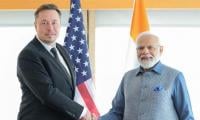Each time a drop of polio vaccine finds its way to the gut of a child, we have taken one more step away from a world where young innocent lives are imperilled by a virus that has no cure.
To most of us it may look like governments and health departments are undertaking this initiative by running vaccination drives. That may only be partly true. Everyone who has children and gets them vaccinated is a polio activist implementing this campaign.
Vaccination is the single most cost-effective means of prevention from disease, saving our children from enduring the catastrophic expenses incurred on treatment and rehabilitation. So clearly, there is both a science and maths to it.
When the reins were given to this government by the people, the country was facing a major challenge with regard to the raging polio epidemic. To stop the transmission of the crippling virus was a challenge the PML-N government accepted. With the right strategies and determination, we were able to achieve a turnaround in the situation, with critics turning into supporters and concern by the international community replaced by applause.
As we step into 2017 with the awareness that our struggle to squeeze out the virus from Pakistan has resulted in the lowest number of cases we have had since 2005, we are confident that we will soon be succeed in completely stopping virus transmission. We closed 2016 with 19 cases as compared to 2015 with 54 cases and in stark contrast to 306 cases in an explosive outbreak in 2014 – a decrease of 94 percent since 2014 and 65 percent since 2015.
The current polio epidemiology remains the best we have ever seen but we need to continue with the same momentum to interrupt virus circulation. As in all eradication initiatives, the virus becomes resilient before finally giving in. We must not relent in our efforts and mobilise all resources – the Sehat Muhafiz, the community, opinion leaders and administrative leaders – to safeguard the health of our children.
During these past 12 months, we have seen many ups and downs. The key challenges involve reaching all the highly mobile population in Pakistan that moves across provinces but also across borders. The challenge in sustaining the immunity of children is also hampered by the limited access to adequate healthcare infrastructure leading to the low coverage of routine immunisation in underserved areas. However, thanks to our dedicated workforce of over 250,000 frontline health workers, our global and local partners and our informed and motivated communities and parents, we have achieved over 99 percent of our vaccination targets during 2016.
The question remains: how are we going to fare in the last stretch to eradication and will we be able to sustain the gains made so far? The answer is: yes we can and yes we will.
In 2017, I am confident that together, we can sustain the high quality of work we are doing and defeat this crippling virus. We will continue to move at scale and will require the support of every parent in Pakistan to vaccinate their child during every round. In support, the government of Pakistan remains committed to reach a zero-polio state and deliver on the national and international commitments it has made. The core strategy elaborated in the National Emergency Action Plan remains on course. This has been designed to root out the virus in the reservoirs, detect and react aggressively to any outbreaks and maintain population immunity levels elsewhere in the country.
Comprehensive plans for high-quality campaigns to reach every child in Pakistan, every time the vaccine is offered, have been made and put into action. The programme is being implemented at scale – every month – targeting 37 million children under the age of five during every national campaign, and 20 million children during targeted campaigns. During the campaigns, a key focus will be reaching children from mobile families.
Another key strategy will be the implementation of combined Oral Polio Vaccine and Injectable Polio Vaccine in campaigns organised in core reservoir districts and other high-risk districts to boost individual immunity of children. The Expanded Programme of Immunisation will also enhance routine immunisations service delivery in the reservoir areas.
Polio eradication continues to enjoy political and popular support in Pakistan and this commitment has made a difference when people come together to work beyond political lines towards a national cause. Underpinning all of our programmatic activity has been sustained government management and oversight at every level. Particular appreciation goes to the provincial leadership who have driven these changes. While there are only 11 tier-1 or highest risk districts on the national risk register, all of our 164 deputy commissioners must act as if his or her district is a tier-1 district.
We are also actively searching for pockets where the virus is hiding. A heightened community search is taking place to look for paralysis cases. In addition, more samples are being taken from the environment to determine where the virus is. As we continue to enhance the sensitivity of our surveillance system, we expect more of the virus to be revealed. This is a critical step as we edge closer to stopping transmission. We must remember that bad news now is ultimately good news for us and enables us to respond quickly.
We have entered 2017 with the awareness that we are very close, but the job is not done yet. A critical lesson learnt from 2016 is that we didn’t have the same focus on the selection and deployment of well-trained and supervised female vaccinators with a realistic work burden. The vaccinator at the doorstep is our most critical asset in the programme and having the right supported workforce remains an essential key to success. Another gap which has been identified is the need to have quality micro-plans to track and vaccinate newborn, guest and transit children in a timely manner across the board.
With a highly mobile population in Pakistan, unless every child is tracked and vaccinated there is a high risk that the virus transmission will continue. Lastly, children who do not receive polio vaccination during their routine immunisation remain vulnerable to viral infections – particularly in areas covered in National Immunisation Days only. This is compounded by low levels of malnutrition which challenges us to reach desired immunity levels – which is why we urge parents to vaccinate their children.
Closing the immunity gap of newborn children before these infants begin to fully participate in transmission is a race against time. To achieve our goal of stopping transmission and sustaining it until the certification of polio eradication, we must work to make progress in routine immunisation service delivery.
Pakistan’s Polio Eradication Initiative has a strong foundation and structure to adapt to operational realities on the ground. We have developed national expertise, knowledge and systems to find the virus, to prepare communities and parents to help safeguard their children and to ensure that all resources engaged in this venture are put to the best use. This is an invaluable experience.
We are now entering the low-transmission season where the virus is most vulnerable. We must use the upcoming campaigns to vaccinate children and give the virus no place to hide. Every citizen is our soldier in taking the fight to the virus.
The writer is the Prime Minister’s Focal Person for Polio Eradication.
Email: Ayesha.r.farooq@gmail.com
Twitter: @AyeshaRaza13
The cases of Attabad Lake and Gwadar simply highlight the many tragedies that exist around the country
Reaffirming loyalty to democracy as a problem solver can be a good starting point
Unfortunately, Pakistani films and TV dramas have seldom ventured beyond domestic intrigues and love triangles
A woman walks past a building of the International Monetary Fund. — AFP/FileThe annual and spring meetings of the...
Late Benazir Bhutto's daughter Asifa Bhutto Zardari addresses the Christian community in Bihar Colony on January 23,...







